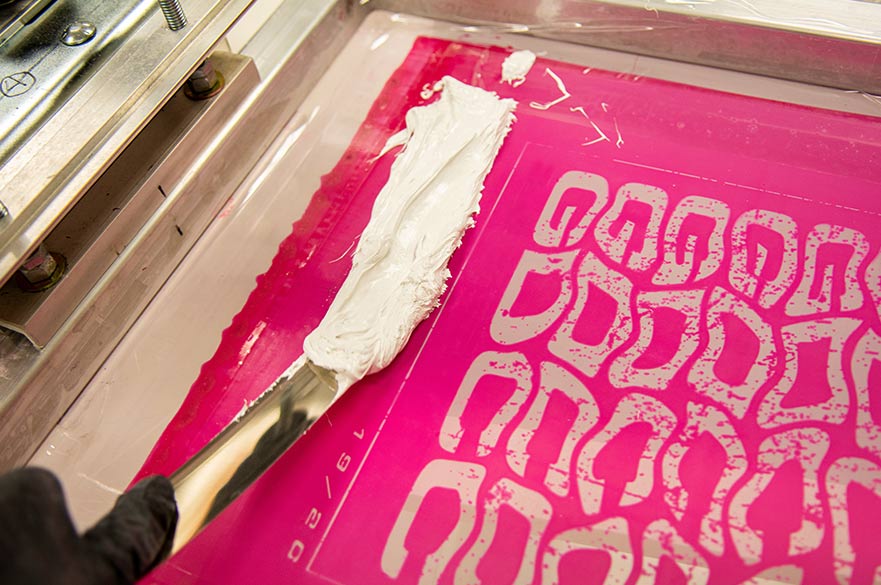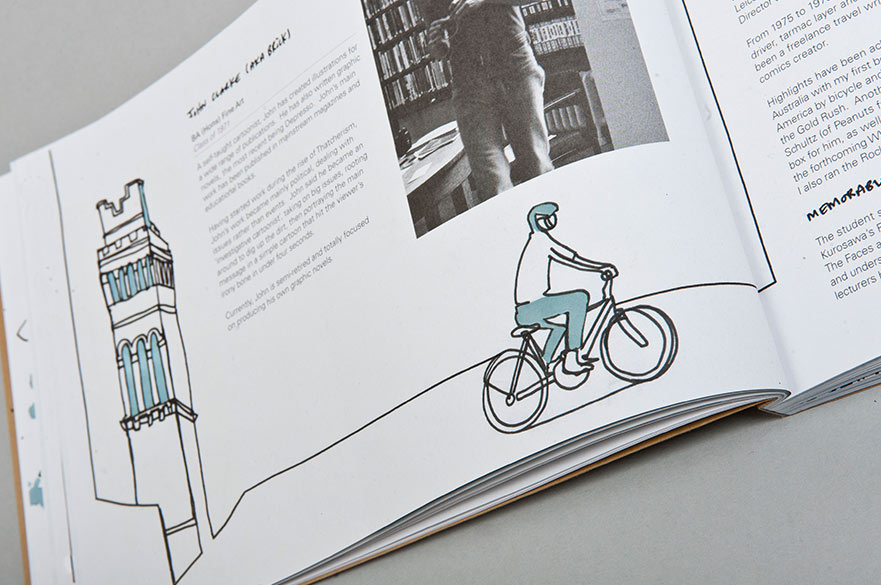Intermediate Graphic Design
- Level(s) of Study: Short course
- Course Fee:
£310
- Start Date(s): 16 April 2026
- Duration: Thursdays 6 - 8.30 pm, six weeks
- Study Mode(s): Part-time
- Campus: City Campus
- Entry Requirements: More information
Introduction:
Course dates:
16 April - 21 May 2026, Thursdays 6 - 8:30 pm
Take your graphic design skills to the next level on this course and learn essential skills like brand development, typography, and layout, all while working on industry-inspired projects.
This course will introduce you to the journey graphic designers take when working in professional practice. You’ll work through the design process of a project from concept to completion, learning the importance of each design stage along the way.
Whether you’re designing for yourself, a client, or an employer, you’ll learn how to create work that’s both visually stunning and strategically effective. With expert-led tutorials and a collaborative studio environment, you’ll refine your creative process, develop a strong visual narrative, and gain the confidence to produce portfolio-worthy designs.
You’ll work on projects and exercises that simulate real-world design scenarios and learn how to think conceptually and practically, always considering the client and their brief.
With a mix of engaging studio activities and tailored tutorials, this is your chance to level up your skills and design with purpose.
-
You’ll be part of a design community in our creative studio culture; one that promotes discussion and collaboration, and encourages experimentation and the constant swapping of ideas.
-
With a limited class size you'll have the one-to-one attention you need to ensure you leave with the skills to continue developing your designs at home or work.
-
Benefit from learning with an experienced tutor who has established links to the profession and significant experience working in varied practices.
-
On successful completion of the course, you will receive a digital certificate of attendance and a digital badge.
What you’ll study
This course mirrors real-world graphic design workflows, ensuring you develop industry-ready skills.
Whilst the course is aimed at professional practice, there is a heavy focus on creativity, how to spark inspiration, develop a strong narrative, and create a process that turns ideas into impactful outcomes.
You’ll spend dedicated time making, experimenting, playing with new concepts, and understanding your audience to create meaningful results.
Working on set and self-initiated projects, including client briefs, you will develop an individual portfolio of work in line with your personal ambitions and future career direction.
Graphic design thrives on creativity, and working in a group exposes you to different artistic styles, ideas, and problem-solving approaches. On this course you’ll work with likeminded people and see how others tackle the same design challenge to spark fresh inspiration and push your creativity further.
Professional designers rarely work in isolation; they are constantly engaging with clients, art directors, and marketing teams. On this course will learn how to communicate design ideas effectively, take feedback constructively, and work efficiently within a team.
You'll work on practical projects and gain insights into:
- professional branding and identity design
- cohesive brand assets that resonate with target audiences
- typography and layout for print and digital
- font selection, grid systems, whitespace, and hierarchy for stunning compositions
- colour theory and print production
- print-ready designs, exploring CMYK, Pantone, and finishes like foil stamping
- building a portfolio that gets noticed
- create standout work and learn how to present it professionally to clients and employers.
You’ll develop both technical expertise and creative confidence, ensuring you can work to industry standards while pushing the boundaries of your design potential.
Here’s a breakdown of what you’ll study during the course:
- Week 1: Industry Insights and Professional Inspiration
- Week 2: Working to a Client Brief
- Week 3: Typography, Colour and Layout
- Week 4: Workflows and Experimental Design Techniques
- Week 5 and 6: Portfolio Building and Professional Practice
Understand how professional designers work, discover award-winning campaigns, and research industry trends to develop your unique design style.
You’ll learn how to develop a professional design mindset and stay competitive in the industry.
Key Topics:
- Understanding the Industry: Print, branding, advertising, editorial, packaging, and complementary practices
- Professional Inspiration Sources: Design agencies, award-winning campaigns, Behance, and print design trends.
- Creating a Market-Ready Visual Identity: Developing a recognisable style while adapting to client needs.
- Hands-on: Research a real-world brand and create a visual inspiration board based on industry trends.
Work on a simulated client project, exploring ideation, sketching, and file setup for print and digital design. You’ll also consider structured workflows used by agencies and freelancers.
You will develop an initial concept layout for a branding project, considering:
- Client brief analysis: Breaking down project requirements, deadlines, and deliverables.
- Sketching and ideation: Using thumbnail sketches, rough layouts, and wireframing before digital execution.
- File Setup for Professional Output:
- o Print: CMYK, bleeds, margins, die cuts, and spot colours in Adobe Illustrator & InDesign.
- o Digital: RGB, resolution, and export settings for social media and web assets.
Refine your ability to create compelling compositions using advanced typography and colour techniques.
You’ll create a magazine spread, poster, or packaging design that meets real-world print standards and apply design principles with a focus on real-world applications.
This session will focus on:
- Typography for Professionals: Kerning, tracking, leading, OpenType features, and font licensing for commercial use.
- Best practices for editorial layouts, advertising, and packaging.
- Advanced Colour Management: Choosing and applying Pantone colours, spot colours, and CMYK profiles for print. RGB vs. CMYK pitfalls and how to proof colours for different outputs.
- Professional Layout Techniques: Using grid systems, whitespace, and hierarchy to create balance and structure. Working with Adobe InDesign for multi-page documents and print-ready layouts.
Explore creative methods like handmade typography, texture blending, and specialty printing to create unique, high-impact visuals.
You’ll develop unique, high-end, and experimental designs that stand out in the industry and design a limited-edition poster or luxury packaging concept incorporating high-end techniques.
This session will focus on:
- Blending Analog & Digital: Incorporating scanned textures, handmade typography, and mixed media.
- Photoshop for Professional Effects: Non-destructive retouching, blend modes, and smart object workflows.
- Specialty Printing Techniques: How to prepare files for foil stamping, letterpress, screen printing, and embossing. Understanding paper stocks, coatings, and finishing processes.
Learn how to present, package, and market your work like a professional.
During the final two sessions, you will:
- Building a portfolio for clients and agencies, choosing strong pieces that showcase versatility. Present projects in mock-ups and case studies.
- Understand final file delivery and asset exporting.
- Print projects: packaging files with outlined fonts, correct colour profiles, and high-res PDFs.
- Export for social media, web banners, and brand assets in multiple formats.
How you’re taught
By the end of this course, you’ll be equipped to navigate every stage of the graphic design process with confidence, from client briefs to deliverables.
You will leave with two portfolio worthy pieces: an instant book output with correct colours and print specifications and a poster or packaging concept.
You’ll also have a good understanding of the process taken in professional graphic design practices when taking on a new project. You will have learnt about the importance of each design stage and why it’s crucial to gather as much information from the client brief as possible.
This course will be delivered in person on Nottingham Trent University city campus.
Contact hours
You will receive 15 contact hours of quality tuition with an experienced tutor.
Careers and employability
Graphic design is a fast-growing industry with endless opportunities. This course will help you build a portfolio and gain the practical skills needed to attract clients, secure job opportunities, or take your existing career to the next level.
Our past students have gone on to work in graphic design, branding and identity, editorial design, marketing and art direction.
Certificate of attendance and digital badge
Upon successful completion of the course, you will receive a digital certificate of attendance and a digital badge powered by Accredible.
Your digital credential is more than just a certificate – it’s secure, verifiable, and protected against fraud through encryption and blockchain technology.
They also come with detailed metadata, including an overview of the skills you have achieved on the course, evidence of completion, and assessment criteria if appropriate.
Share your achievements seamlessly with friends, customers, and potential employers online, and proudly add your badge or certificate to social media platforms such as LinkedIn, so all the right people can see it.
Campus and facilities
You will be based in the Nottingham School of Art and Design on the City Campus in our new Design & Digital Arts Building.
You'll have access to industry-standard facilities which include collaborative studio spaces, future technology suites and exhibition spaces. You’ll work in our spacious Mac suites equipped with industry standard software including Adobe Creative Cloud.
You will receive an email one week before the course starts with joining instructions on where to go for the first day.
You’ll also have access to our library to use outside of your short course; whilst you can’t reserve or take away books, you are welcome to use them as a resource for research and referencing.
Entry requirements
Level: Intermediate
Entry requirement: You should have completed a beginners graphic design course at NTU or elsewhere, or have some professional experience.
Experience with Adobe is essential; you should have a basic understanding of tools and within InDesign, Illustrator and Photoshop.
If you’re looking for a course solely to learn software skills, take a look at our courses in Adobe InDesign, Adobe Photoshop, Adobe Illustrator and Adobe After Effects for Motion Graphics.
You must be over the age of 18 in order to attend this course.
Fees and funding
The fee for this course is £310.
Payment is due at the time of booking - ask us if you'd prefer an invoice sent to your company.
Secure your place with a deposit- If you're booking more than two months before the course starts, we can accept a £200 deposit to secure your place, and the balance is due one month before the course starts.
Your course fees cover the cost of studies and include great benefits such as the use of our modern library and free use of the IT equipment and software on the campus during your course.
You will also need to bring with you:
- A notepad and pen
- a layout pad
- drawing materials (pencils, felt-tips, gel pens etc)
- USB stick with images you’d like to work with or anything else relevant you’d like to practice on
- You can bring your own laptop with Adobe software loaded (if preferred), although Macs will be available to learn on in the classroom (you will be shown the keyboard differences on the course if you are used to working on a PC).
- You will be taught how to use Adobe InDesign, Illustrator and Photoshop and have access on campus, but you may also want to consider purchasing the software to use outside the course for practice, and to continue your development after the course.
You can read the terms and conditions of booking here.
How to apply
You can book your place via the NTU online store:
16 April - 21 May 2026, Thursdays 6 - 8:30 pm
Browse all our design and digital arts short courses.
Any questions?
Contact the short course team:
Email: creativeshortcourses@ntu.ac.uk
Telephone: +44 (0)115 848 2813


